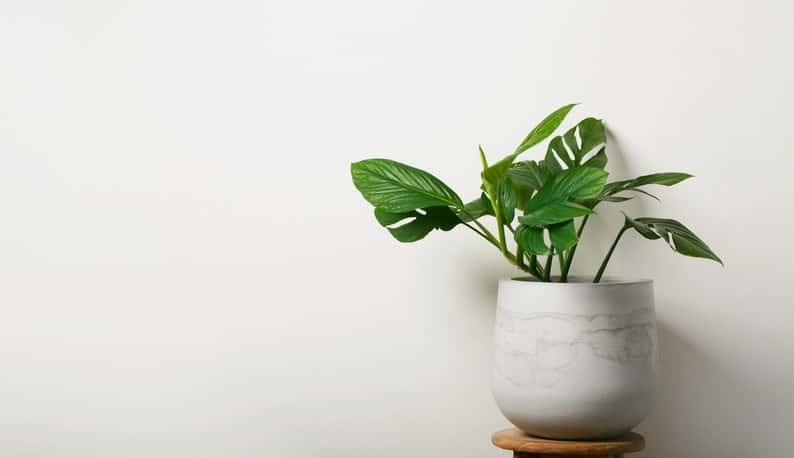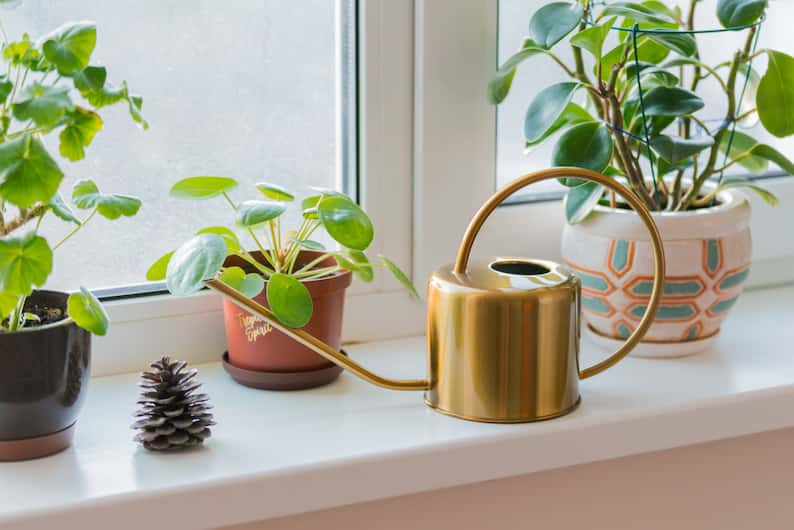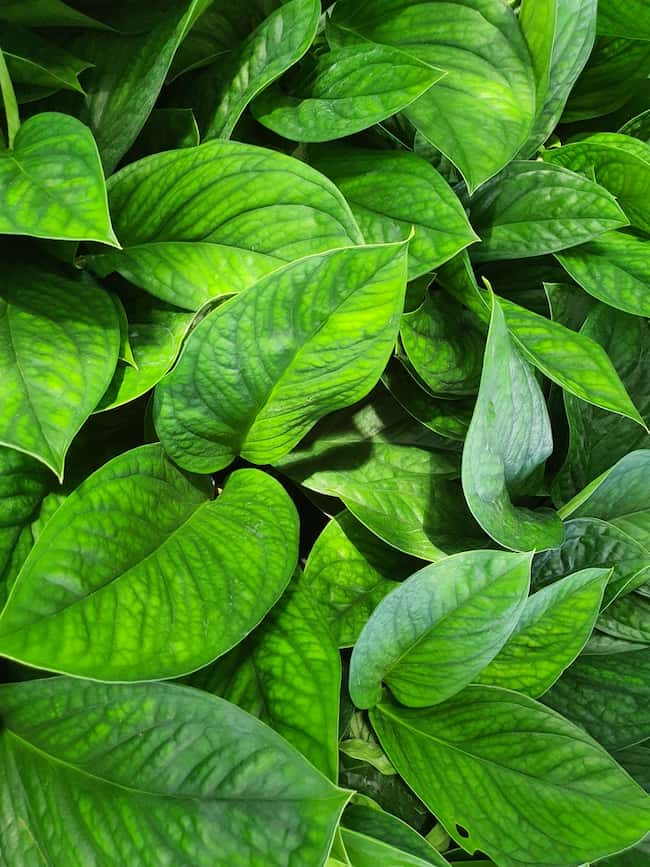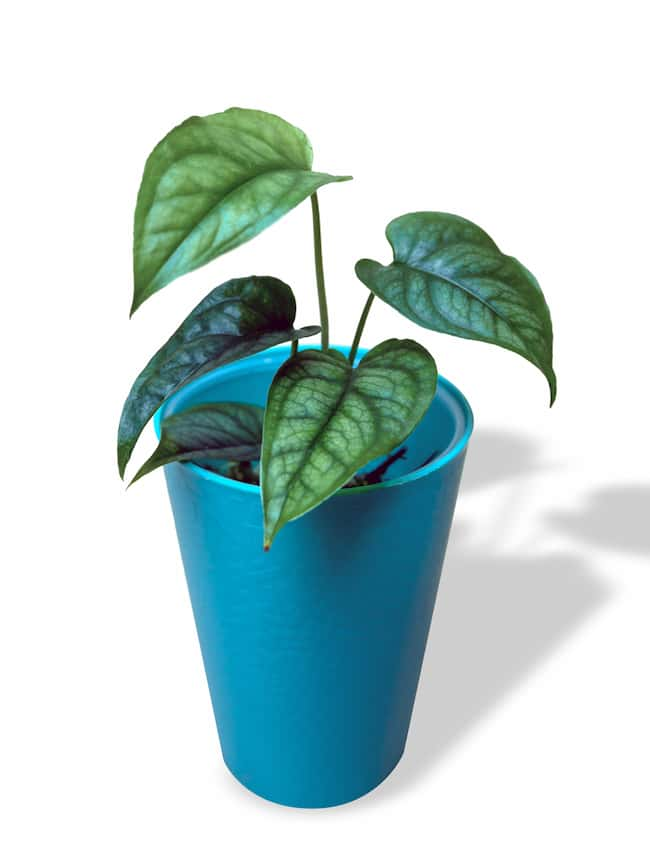The Monstera Pinnatipartita is a truly spectacular member of the Araceae family that has risen in popularity in the last two to three years. Native to Ecuador, Colombia, and Peru, this unique jungle-dweller is beloved for the deep and unusual fenestrations it develops as it matures and for its striking bi-colored leaves. Its dramatic transformation as it grows older is part of what makes it such a pleasure for houseplant collectors.
In good news, the Monstera Pinnatipartita is also becoming easier to obtain. Although still considered rare, it is now possible to purchase a cutting of this beauty from online suppliers and specialist breeders. Occasionally, you may even come across one in your local nursery or garden center.
If you’re considering investing in a Pinnatipartita, or you already have one and want to brush up on your knowledge, you’ve come to the right place. In this post, we’ll explore everything there is to know about caring for this gorgeous plant, from its environmental needs to how to train and propagate it. Let’s dive right in.

Table of Contents
How do you care for a Monstera Pinnatipartita?
To keep a Monstera Pinnatipartita happy and healthy, you need to ensure its needs are met in terms of water, humidity, light, soil, and nutrition. As a tropical plant, it prefers warmer climes and high humidity, a consistent watering regime, aroid soil, and occasional fertilization.
Perhaps one of the reasons Monstera make such popular houseplants is because they’re easy to care for. Even rare varieties, like the Pinnatipartita, aren’t particularly fussy, so long as they have consistency in their environments.
To best understand how to care for a Pinnatipartita (or any Monstera for that matter), it’s ideal first to have an overview of their natural growing habitats. In the wild, these plants are understory creepers, which means that they grow in the shadow of larger trees to which they can eventually attach their aerial roots to climb.
They live off the rich organic matter embedded in the soil of the forest floor and absorb energy from the sunlight filtering through the canopy above them. Indoors, these conditions can be emulated to a certain degree by taking care of their placement in the home and making sure they have plenty of humidity and water.
It is also advisable to give them a little extra boost by way of a slow-release organic fertilizer. This is most effective if added to a good quality soil mix with adequate air circulation and moisture retention. We’ll cover its exact needs in terms of light, soil, water, and humidity shortly, but first, let’s look at its fundamental requirements.
1. Selecting the right plant or cutting
Caring for your Pinnatipartita starts from the moment you purchase your plant. When selecting a cutting or established plant, it’s essential that you find a healthy specimen without any pests or diseases on the Monstera.
Carefully inspect your plant to ensure it shows no signs of yellowing, drooping, or insect infestations. If you’re going the cutting route, make sure the stem has two to three leaves and at least two healthy nodes.
2. Make sure you have an appropriate planter
Ideally, your Pinnatipartita is going to live in its pot for up to two years before it needs to be transplanted. For this reason, you want to select a container that is a good size for your Monstera and has suitable drainage holes. It also helps if it’s pretty sturdy, as these beauties grow fast.
While it can be tempting to select a pot that is large enough to make room for growth, this isn’t necessarily good for your plant. Too much soil can be tough on a Pinnatipartita’s roots, mainly when you’ve just watered it. Instead, to get the best pot for your Monstera, opt for a planter twice the width and depth of your plant, and repot your Monstera only when necessary.

3. Choose a spot with the right heat and light for your Pinnatipartita
Where you place your Monstera will ultimately have a bearing on how well it fares as it matures. More often than not, this variety of Monstera is purchased as a houseplant. However, it can survive and thrive outdoors, provided you live in a warm climate with moderate to high humidity.
Most Monstera are cold-tolerant, but the Pinnatipartita will start to suffer if temperatures drop below 55F (12C). In sunny gardens, they do best in raised beds that receive 6 to 8 hours of dappled light through the leaves of other trees.
How much light does a Monstera Pinnatipartita need?
Like almost all Monstera varieties, the Pinnatipartita does best with bright but indirect light. They are susceptible to scorching, so it’s not a good idea to place them in a spot where the sun hits them directly. A few feet back from a North-facing window, with access to light for six to eight hours a day, is ideal.
If you’re growing your Monstera outdoors, stick to a spot that gets shade from a tree or wall, or invest in a shade cloth to partially protect it from the sun’s harsh rays. A greenhouse or conservatory is first prize.
While they prefer lots of light, Monstera Pinnatipartita will also survive well in lower light conditions, such as in a bathroom. They may just not grow as quickly as usual or produce as many new leaves.
Related: How Much Light Does Your Monstera Need?
4. Provide a climbing structure
Monstera Pinnatipartita are hemi-epiphytes, which means they have both ground-growing terrestrial roots and aerial roots. When these Monstera are in the wild, their aerial roots attach to host plants, which allows them to grow upwards towards the sun.
Indoors, it’s a good idea to provide your Pinnatipartita with a climbing structure, like a moss pole or trellis, so that it has somewhere to vine. Alternatively, you can grow your Monstera in a hanging basket, allowing its stems to trail downwards.
Related: 6 Simple Steps to Stake a Monstera
5. Regularly inspect your plant
An occasional bout of ill health can be avoided by regularly inspecting your Pinnatipartita for any signs of distress. Fortunately, these plants are great communicators and will indicate when something is amiss. If caught early, most common afflictions affecting Pinnatipartita can be easily resolved.
Give your Monstera a once-over every one to two weeks to make sure it shows no symptoms of wilting, yellowing, or pests. Also, be on the lookout for foul-smelling soil that may result from overly moist soil.
6. Prune as needed
None of us like to lop away at our houseplants, but regular pruning is part of the maintenance and care of a Monstera Pinnatipartita. Cutting away dead or old leaves makes room for new growth and prevents your plant from expending energy on leaves and stems past their prime.
Related: How to Prune Your Monstera: The Ultimate Guide
7. Water your Pinnatipartita when its soil says so
Pinnatipartita love water, but you do need to strike a balance between keeping it moist and accidentally drowning it. The most common cause of fatalities in Monstera is root rot, which usually results directly from overwatering your Monstera. Save yourself the trauma by testing your soil for excess moisture before adding water.

How often to water a Monstera Pinnatipartita
As a rule of thumb, a Monstera should be watered once per week during the hotter months and once every ten to twelve days during the winter, but ultimately the best approach is to monitor its hydration needs instead. Do this by waiting until the top few inches of your Pinnatipartita’s soil completely dry out before watering it.
Caring for these houseplants would undoubtedly be easier if there were hard and fast rules about how often to water a Monstera, but sadly this is not the case.
To test the soil for dryness, insert your fingertip into the soil and feel if it’s damp or dry. If the ground is cloggy and dense, you still have a few days to go. And if all else fails, invest in a moisture meter.
What’s the ideal humidity for the Monstera Pinnatipartita?
Pinnatipartita love humidity above all things. While they can survive normal indoor humidity levels of 30% to 50%, they really prefer to be in the 50% to 60% range, which is probably why they love bathrooms so much.
If you’re looking to give your Pinnatipartita a little extra dose of moisture in the air, you may want to consider investing in a damp pebble tray or a plug-in humidifier. Failing this, you can create a humid environment for your Monstera by clustering several houseplants close together. Regular misting is also a fantastic way to keep your Monstera’s foliage moist and healthy.
What’s the best soil for a Monstera Pinnatipartita?
The beautiful Pinnatipartita loves a good aroid mix that is well-draining, aerated, and rich in nutrients. An ideal combination is a high-quality potting soil combined with orchid bark or peat moss for air circulation and perlite for moisture retention. A little dose of activated charcoal also goes a long way to ensuring your pH level stays optimal (5 – 7.5).
To grow their big, beautiful leaves, Monstera need lots of nutrients, which is why it’s essential to keep them in soil rich in organic matter. If you’re not up to the task of mixing your own soil, you can purchase specialized Monstera blends from most nurseries and garden centers.
Related: What’s the Absolute Best Soil for Monstera Plants?
How to fertilize a Monstera Pinnatipartita
When selecting a fertilizer for your Monstera, stick to a 10-10-10 or 20-20-20 slow-release liquid mix. Dose your Pinnatipartita once per month during the spring and summer and restrict feeding in the winter. With your initial feeding, opt for a slightly lower dose than called for in the instructions of your selected brand.
This gives your Pinnatipartita time to adapt. If you notice wilting or yellowing shortly after feeding, hold off for a month or two, as you may be giving too much fertilizer to your Monstera.
Try as we might, it’s almost impossible to replicate a Monstera’s rich natural habitat. What we can do, however, is boost their nutrient intake with a well-balanced fertilizer. Regular feeding in the way described above is beneficial for Monstera Pinnatipartita care and can set it on its way to renewed vigor.

How to propagate Monstera Pinnatipartita
Monstera Pinnatipartita can be propagated both from stem cuttings and from tip cuttings and can be rooted in water first or directly into soil. This variety of Monstera propagates exceptionally well in conditions where it receives lots of light and humidity.
There’s more than one way to propagate a Monstera Pinnatipartita. In fact, this gorgeous specimen propagates equally well in water and soil. That being said, a large part of your success depends on the condition and size of your cutting. For best results, you want to select a relatively leafy bit of stem with more than one node.
Before making your cutting, ensure your shears or scissors are clean and sterilized. This will curb the potential spread of diseases. Always slice stems at a 45-degree angle, allowing a larger surface area for new growth. Strip away excess lower leaves so that one-third of the stem cutting is clean.
When taking cuttings from a Monstera Pinnatipartita, make sure not to cut away more than 30% of your plant. This can cause distress to the parent plant, from which it may not recover.
Let’s have a quick look at how to root a stem cutting using either a water jar or a soil planter.
How do I root Monstera Pinnatipartita?
Once you have your cutting ready, decide if you want to root it in water first or submerge it straight into a prepared planter. For water propagation, make sure you keep your stem cutting in its container close to a sunny window so that it can absorb plenty of energy. Refresh the water once per week.
That is, once you have obtained a Monstera Pinnatipartita cutting, your next step is to set it up for rooting. This is the phenomenon whereby new roots develop from nodes or cut stems after either submerging them in water or planting them into a prepared soil mixture.

You should see new growth forming from your cutting’s nodes in under two months if you follow the steps outlined above. From there, when the new roots are one to two inches long, you can plant your cutting in soil and care for it as you would any established houseplant.
If you plan to plant your cutting straight into a soil mix, the critical factor to rooting will be how much humidity out plant receives. As it has not yet got roots of its own, it cannot draw moisture from the soil, so supplemental humidity is a must. The best way to go about this is to cover your planted cutting with a plastic bag or container that locks in dampness from the air. In a few weeks, it should settle and grow new roots.
For a little extra vigor, dip your cutting in rooting hormone before planting it in its container.
Can Monstera Pinnatipartita live in water?
Technically yes, Pinnatipartita can live in water, but it’s not a good idea to keep them there indefinitely. Generally speaking, they should be transplanted into soil as soon as they have rooted sufficiently. If they’re left in a container with water for too long, they may become rootbound, which ultimately stunts their growth.
Water alone may also not provide them with all the nutrients and minerals they need to thrive.
Related: 6 Easy Steps to Grow a Monstera in Water
Is Monstera Pinnatipartita fast growing?
Monstera Pinnatipartita grow at a moderate to fast rate. In excellent indoor conditions, they can expand by 1 to 2 feet (30cm to 60cm) per year. Outdoors and in greenhouses or conservatories, the speed at which they grow can double.
If you’re looking for a houseplant that rewards you with new leaves on your Monstera on a regular basis, the Pinnatipartita is for you. While not as fast-growing as its cousin the Monstera deliciosa, the Pinnatipartita is still a gratifying houseguest and grows faster the larger it becomes.

Interestingly, the rate at which it grows is not nearly as memorable as the way in which it grows, undergoing two distinct phases. A juvenile Monstera Pinnatipartita has small, whole oval leaves colored with shades of light and dark green. But as Monstera Pinnatipartita mature, their leaves enlarge exponentially and become covered in slit-like fenestrations that reach all the way to their center veins.
This very distinct aesthetic is what sets the Pinnatipartita apart. The bigger it gets, the more of these large, split leaves it will develop. Therefore, its growth rate is hard to measure, as it depends on the size your Pinnatipartita was to start with.
How do you grow Monstera Pinnatipartita to look bushy?
If you want to get your Monstera Pinnatipartita looking bushy and full, you need to provide it with optimal growing conditions. This means good light, humidity, soil, and lots of water. Furthermore, you can ensure it has lots of access to nutrients by employing added fertilizer or compost.
When Pinnatipartita look sparse and don’t seem to want to grow, it is usually a result of a deficiency of some sort. Try moving your plant to a different spot with more light or adding a humidifier to its environment.
Providing your Monstera with a climbing pole or trellis will also encourage it to grow in a structured and bushy way. Unsupported plants tend to look a little scraggly.
Is Monstera Pinnatipartita rare?
Monstera Pinnatipartita has long been considered rare, particularly in comparison to its more popular cousins, the Monstera deliciosa and Monstera adansonii. However, in recent years, this plant has become more popular around the world and consequently easier to obtain.
Houseplants, in general, owe a lot to Instagram, and the Pinnatipartita is no exception. This beauty underwent a wild turn in popularity on the platform somewhere in the summer of 2021 and has steadily crept into our hearts and homes ever since.
While you’re not likely to stumble across a Monstera Pinnatipartita for sale in a grocery store quite yet, you shouldn’t have any trouble buying one online or even in specialist nurseries.
Why are my Monstera Pinnatipartita leaves not splitting?
If your Monstera Pinnatipartita leaves aren’t splitting, the chances are high that it’s just still too young. Pinnatipartita generally only start to fenestrate from 2 to 3 years onwards. If your plant is in this age range, it might have a deficiency stunting its growth.
For many, Monstera’s signature fenestrations are half the reason we buy them. That’s why it can be very frustrating if they refuse to make apertures. In good news, 90% of the time, a lack of fenestration just means you need to be a bit patient, as your plant is still maturing.

On the other hand, if your Pinnatipartita is over two years old and showing no sign of holes anywhere, it’s likely an issue with its care. Move your plant to a spot with lots of bright indirect light, boost it with a little fertilizer, and regulate your watering schedule. Extra humidity also won’t hurt.
You may also be interested in: When Do Monstera Leaves Split?
How to help Monstera Pinnatipartita climb
Pinnatipartita are natural climbers, using trees as host plants in the wild to help them creep upwards toward the sun. Indoors, you can help your Pinnatipartita to climb by providing it with a structure like a moss pole and gently securing it until it can remain attached by itself.
A Monstera Pinnatipartita climbing is a beautiful sight to behold. Their natural instinct is to attach themselves to structures so that they can grow upwards, but indoors they may need your help.
First, select an appropriate support for your plant. Attaching your Monstera to a moss pole or coco coir pole is a great idea because their texture is similar to that of trees in the wild. They can, however, also vine along trellises and fences.
To help your Monstera Pinnatipartita climb, you can secure it to your chosen structure with thin twine, florist’s tape, or clips. Gently attach it across the stem but under its leaves, making sure not to obstruct its aerial roots. As soon as the roots have settled, you can remove your twine or tape.
What’s Monstera Pinnatipartita’s common name?
A Monstera Pinnatipartita is often referred to as a hurricane plant, a Mexican plant, a Swiss Cheese plant, or (incorrectly) a Split Leaf Philodendron. The most common of these is Swiss Cheese plant, although that moniker is used interchangeably for several varieties of Monstera.
Perhaps if this beauty had an easier name to pronounce, it wouldn’t suffer from such an identity crisis. Alas, the Pinnatipartita is a plant of many nicknames, the most inappropriate being Split Leaf Philodendron, which isn’t even a Monstera to begin with.
Monstera Pinnatipartita vs Monstera Peru
The main difference between the Monstera Pinnatipartita and the Monstera Peru is that the Peru produces no fenestrations. While they have similar-looking leaves as juvenile plants, the Pinnatipartita develops large fenestrations, distinguishing it from the Peru.
As juveniles, the Pinnatipartita and the Peru are quite easy to confuse, although the Pinnatipartita has a more blistered texture on its leaves. As they mature, however, the Monstera Peru remains utterly devoid of apertures, while its counterpart starts to split from as young as two years.
Monstera Pinnatipartita vs deliciosa
The main difference between the Monstera Pinnatipartita and deliciosa is in the shape and size of their fenestrations. While they are similar in appearance, both being larger species of Monstera. the Pinnatipartita’s apertures extend from leaf edge to center vein, whereas the deliciosa’s do not.
The Pinnatipartita and the Monstera deliciosa have a lot in common and are easily mistaken for one another. Both plants have thicker stems and a less vine-like appearance than many other Monstera. However, they become easy to differentiate at maturity, as the Monstera develops both holes and splits, neither of which reach the center rib of their leaves. The Pinnatipartita, on the other hand, has fenestrations of equal sizes that extend from edge to center.
Is Monstera Pinnatipartita the same as the Split Leaf Philodendron?
The Pinnatipartita is often mistakenly referred to as a Split Leaf Philodendron, but these plants are not the same. While related, Monstera and Philodendrons are not even part of the same genus. These two plants simply share aesthetic traits, which leads to their mistaken identity.
The fact that both these plants have split leaves can be confusing, but a surefire way to identify a Split Leaf Philodendron vs a Monstera is to see whether or not it climbs. Where Pinnatipartita love to attach themselves to things, true Philodendrons do not.
